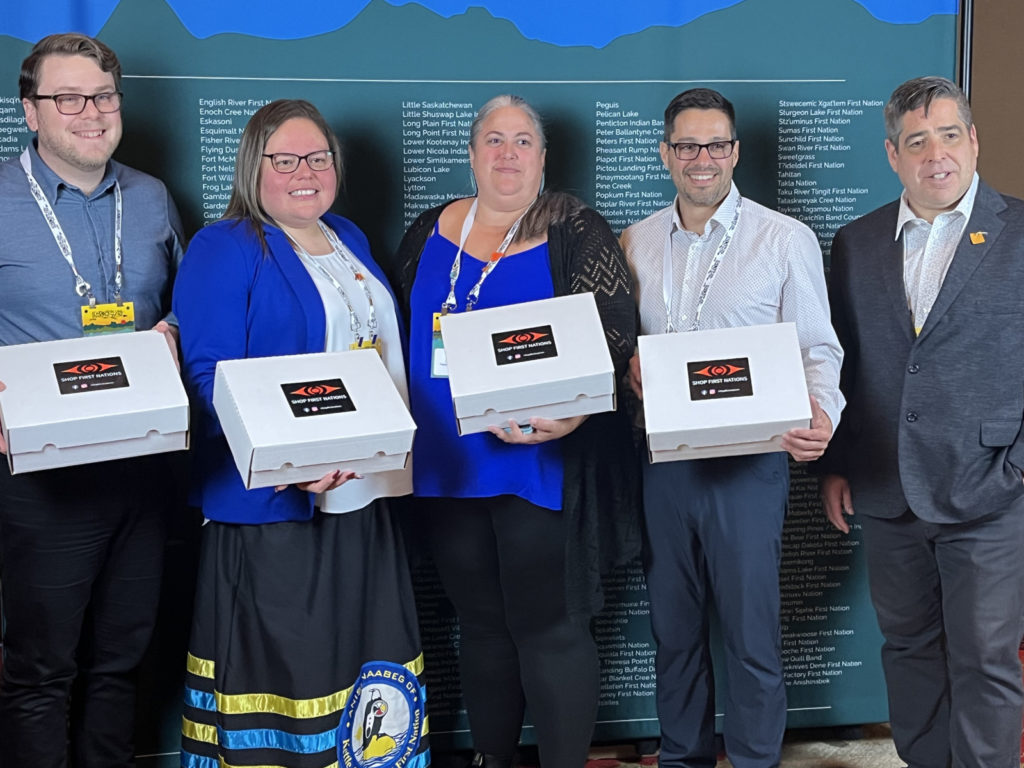Chief Kimberly Bressette, second from left, with other panelists at Leading the Way: from left to right, James MacKinnon, Paula Pictou, Darcy Gray and Jason Calla.
The number “two” has several applications for the Chippewas of Kettle and Stony Point First Nation. The Nation is made up of two reserves and the distinctive rock features that provide the “Kettle” part of its name are found in only two countries in the world.
The Nation is also one of two communities that have been working with FNII in what are called “proof of concept” projects (Paqtnkek Mi’kmaw Nation of Nova Scotia is the other).
The concept to be proven is that the First Nations Infrastructure Institute (FNII) is beneficial for communities as they navigate their way through complex infrastructure projects. During Leading the Way, Chief Kimberly Bressette described her Nation’s work with FNII in planning to replace an aging wastewater plant. FNII Technical Advisor Jason Calla also participated in the presentation to explain how important a business case is for projects like this.
Chief Bressette started by providing some background about her Nation. Chippewas of Kettle and Stony Point are located approximately 35 kilometres northeast of Sarnia, Ontario, on the southern shore of Lake Huron. The Nation has a land base of approximately 1,096 hectares and an on-reserve population of just over 2,100 people.
The two reserves that make up the Nation are Stony Point – or Aazhoodena – and Kettle Point – known as Wiiwkwedong. The latter is named for the distinctive spherical rock formations that erode from underlying shale beds along the shore of Lake Huron. These formations are known as “kettles” because they look like large pots. They are only found in Canada and New Zealand (Manitoba has the only other kettles in Canada).
The wastewater plant on reserve was built in 1994 and it is nearing the end of its lifecycle. It’s only performing at 50 per cent capacity – and sometimes not even that much. Other Nation infrastructure includes three housing subdivisions, a school, health centre, police station, day care, car wash, child and family health services office, and a mental health and wellness hub.
Some residences on the reserve are not connected to the wastewater system (they use septic fields instead). These include cottages along the scenic lakeshore that have been built on land leased to non-Band members. The planned replacement and expansion of the wastewater plant will allow these residences and cottages to be connected to the system, says Chief Bressette.
“We would also like to build more housing and a multiplex sports and activity centre,” she says.
These big-picture plans are all part of the business case that should be developed when a community is assessing its infrastructure needs for development or replacement says Jason Calla.
“A business case is a one-stop shop to describe an infrastructure project, allowing people to easily understand your rationale and process,” he says.
The key parts of an infrastructure business plan are:
- Strategic – why are you doing the project, what problem are you solving
- Technical – the feasibility of options, cost estimates
- Commercial – how the project will be tendered, the procurement model
- Financial – how the project will be paid for, including planning, construction, operations and maintenance
- Management – how to manage the project through the lifecycle of the infrastructure
The Chippewas of Kettle and Stony Point are now finalizing the technical case of their business plan and are considering options for the commercial case. They are also looking at the future.
“We hope to have a plan that estimates when infrastructure needs to be replaced,” says Chief Bressette.
This is the kind of planning FNII can help with. Now that the institute is formally established and about to hire permanent staff it is looking forward to the day when it will be working closely with more than two communities.
If you would like to talk about how FNII might work with your Nation (or Indigenous organization), email info@fnii.ca
For more information about infrastructure business plans, see this story from our May newsletter about getting “shovel-ready.”
Listen Up! Podcast Alert
What are the practical aspects of planning for infrastructure growth in communities? Check out this FNII podcast of the on-stage panel discussion with Kettle and Stony Point and Paqtnkek Mi’kmaw Nation from Leading the Way. It is moderated by Jason Calla, FNII Technical Advisor.

